Decades after defying BMC rule that had ordered all overhead utility wires to go underground, authorities finally force South Mumbai to toe the line
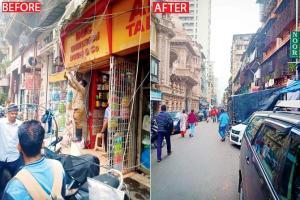
A BMC worker cuts off wires on Nagdevi street; the wire-free stretch post-civic body action a couple of weeks ago
While most of the city was quick to send all its overhead utility wires underground in the early 1990s following BMC's strict diktat, south Mumbai, with its painfully narrow lanes, decided not to. In August, however, following the umpteenth time the fire brigade was halted in its tracks, this time while trying to fight a major fire inside the 112-year-old Tyeb Building in the narrow Abdul Rehman Street at Crawford Market, BMC decided enough was enough. So, why exactly did it take so long?
Post the Tyeb Building fire incident on August 3, the BMC quickly got down to work and cleared the overhead cables from Abdul Rehman Street. However, Vinayak Vispute, officer of B Ward said that such cables are visible on almost all streets in Crawford Market and Dongri areas. One of the fire officers, on condition of anonymity, told mid-day, "Our vehicles are larger than other vehicles and hence, we face a lot of issues while entering the narrow streets of South Mumbai."
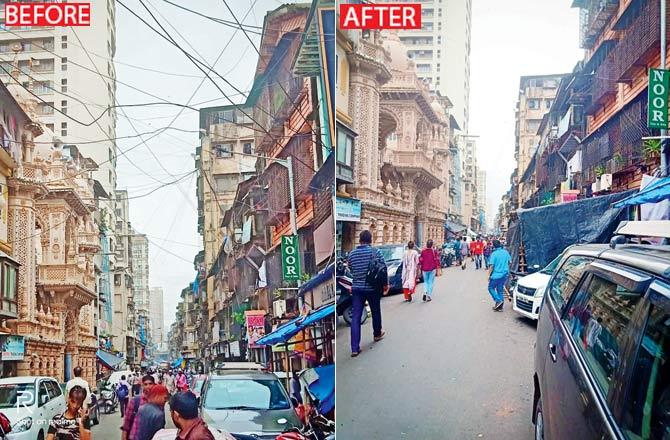
The cable wire-free stretch at Nagdevi Street in Masjid Bunder earlier this month
This is not the first time that dangling cable lines have caused an impediment in fire-fighting operations. Several other cable-related mishaps in the city have proved that this menace is as nightmarish as Mumbai's pothole problem. In the late 1990s, the BMC had issued orders to lay all cables in the city underground. Ward officers were also asked to take action against anyone found flouting the rule.
Despite that, wires of cable TV and internet broadband operators continue to deface the city's skyline. In early 2018, a dumper dragged a hanging wire across the road, leading to the collapse of a streetlight pole. On August 12 last year, Western Railway (WR) saw a massive disruption after a cable snapped on overhead wire at Charni Road during peak hours, leading to cancellation of 54 trains and over 100 services. Soon after, WR took action at 39 spots where cable wires were seen passing over the tracks. However, exactly a year later, on August 8, another cable wire above Mahalaxmi road bridge fell on WR's overhead wire system, leading to closure of all four lines for nearly 20 minutes.
Also Read: Mumbai: BMC plays good cop-bad cop with on-street parking plan
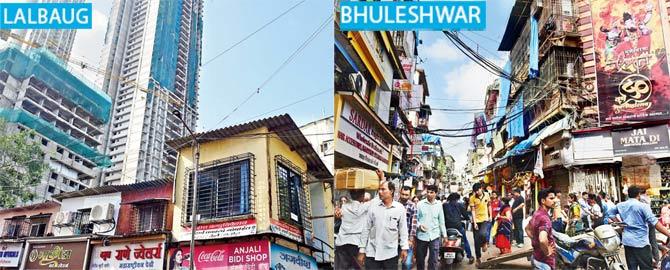
Cable wires can still be seen dangling above several busy streets in the city. Pics/Bipin Kokate
Going underground
The issue of dangling cables has been discussed on several occasions at the ward level, as well as the general body meetings of the BMC. "There is a policy in place, and all service providers are expected to lay wires underground," said a senior BMC official, on condition of anonymity. "Mumbai was the first city in India to become free of overhanging cables in the late 1990s when electricity and MTNL wires went underground. Even the new CNG lines are laid underground, so there is no excuse for dangling cables now," said Pankaj Joshi, director of Urban Design Research Institute (UDRI).
Pravina Morajkar, a corporator from Nehru Nagar, Kurla had demanded a stringent policy against hanging wires in the city, through a notice of motion (NM) in the general body meeting in December last year. "Cable operators are not bothered about these wires. I have seen aged people trip and fall. There should be some policy to stop this nuisance."
Also Read: BMC may copy MMRC's idea to identify faulty bridges
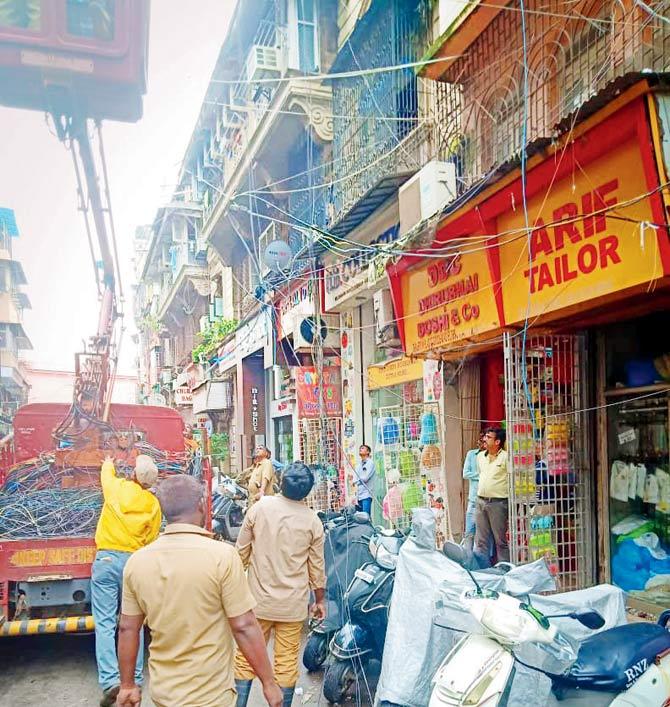
Cable wires being cleared at Nagdevi Street in Crawford Market
Nikita Nikam, corporator from B ward, where the action of removing wires had started two weeks ago, said, "I spoke to other corporators about the issue. If we remove all the wires immediately, it will disrupt public services. We have to take a decision after discussing it with all the stakeholders."
The notice of motion is currently with municipal commissioner Praveen Pardeshi. He told mid-day, "There is already a BMC policy in place that all utility cables and wires should go underground. If any cable operator is found not obey the rules, the ward officer concerned can take action after an inquiry. Cable operators, however, have their own issues to contend with. Though some of them are ready to lay underground cables, they said they would need sops from the authorities to do it.
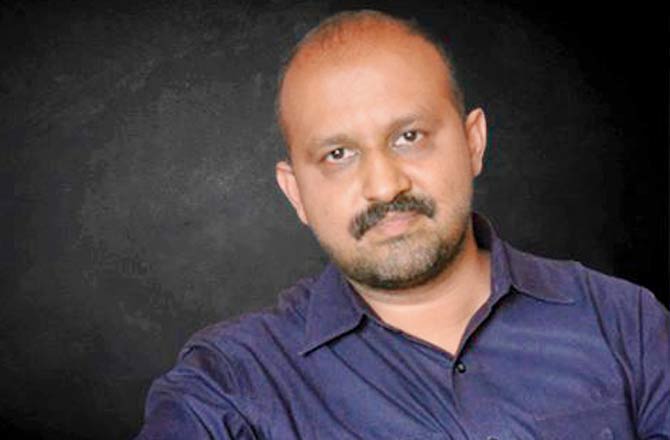
Pankaj Joshi, director, UDRI
Citing the Cable Television Networks Regulation Act, 1995, which states that "any cable operator, may establish cables under, over, along, across, in or upon any immovable property under the control of a public authority", Raju Patil, committee member of the Maharashtra Cable Operators and Distributor Association said that the BMC cannot force or dictate cable authorities to toe the line. "These rules are decided by the Centre," said Patil. "The BMC should discuss the issue with us and provide solutions, like free duct service to lay the wires. After all, we pay taxes in crores to the local body and state government."
Also Read: Mumbai: BMC wants to buy its way into Top 3 Swachhta ranking
Cable operator Vishwanath Girkar agreed that cable wires can be a nuisance. "Often, operators directly connect a wire from the terrace to the first floor on the opposite side of the road. They need to be made aware of the dangers of doing the same," he said.
What's the solution?
"Hanging wires are a poor indicator of the quality of life. It is an unsafe short cut and can lead to deaths. It has to be replaced with an underground facility," said Joshi. The urban planner suggests using a dark fibre system that is adopted by most world-class cities. Dark fibre is an unused fibre that can be used for fibre-optic communication.
Often, network companies lay more lines than needed in order to curb the costs of having to do it again. A client will lease unused cables to other companies that need it. "The dark fibre system is already in use in Mumbai and many cable providers are ready to lease out their dark fibre," said Joshi.
He added that many new housing societies in the suburbs already have provisions for a duct, so it becomes easier for service providers to lay wires underground. "It will, however, increase the cost of infrastructure and will burden cable operators, who are already facing stiff competition," said another cable operator. Girkar added, "Even though the underground cable network will work in the suburbs. It will be difficult to implement it in South Mumbai, where buildings are more than 50 years old, and do not have any proper system."
Aug 8
Day when cable wires fell on the overhead wires at Mahalaxmi station bringing WR to a halt
39
No. of spots at which WR took action against overhead cable wires
Catch up on all the latest Crime, National, International and Hatke news here. Also download the new mid-day Android and iOS apps to get latest updates
 Subscribe today by clicking the link and stay updated with the latest news!" Click here!
Subscribe today by clicking the link and stay updated with the latest news!" Click here!









